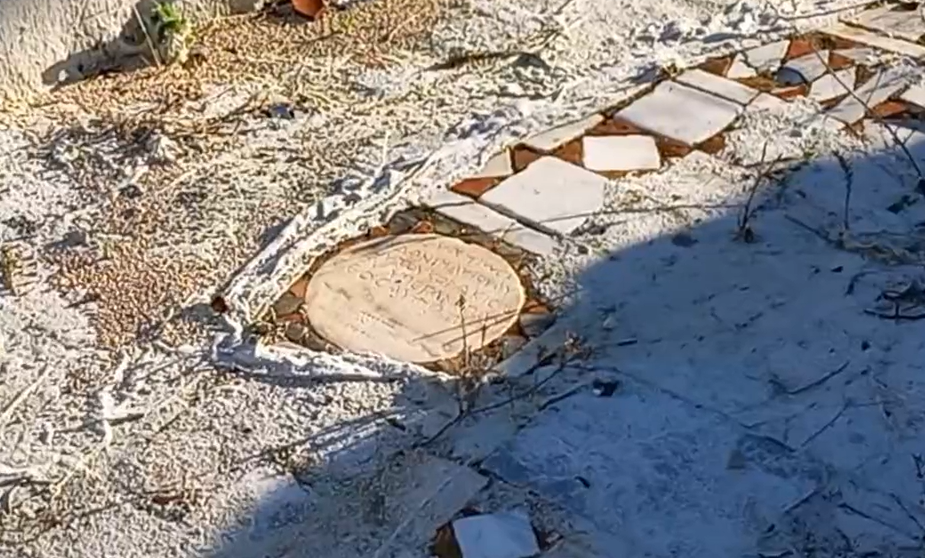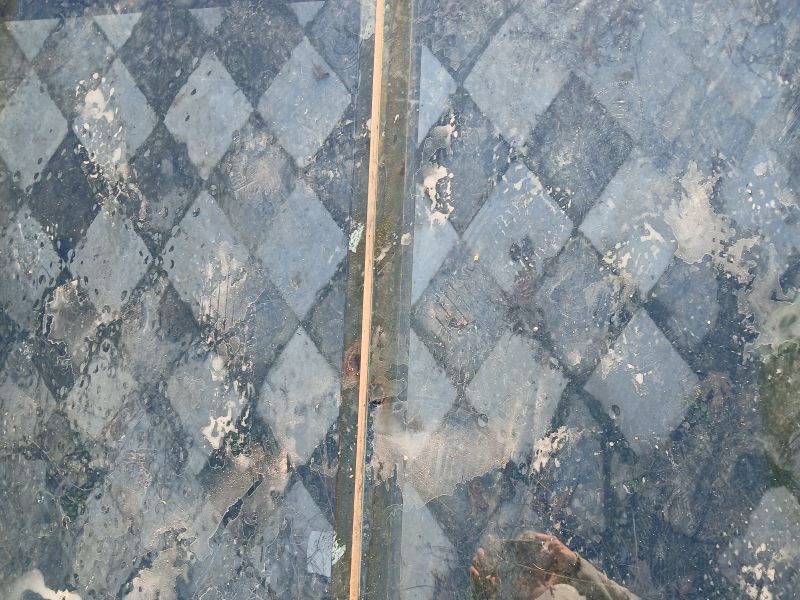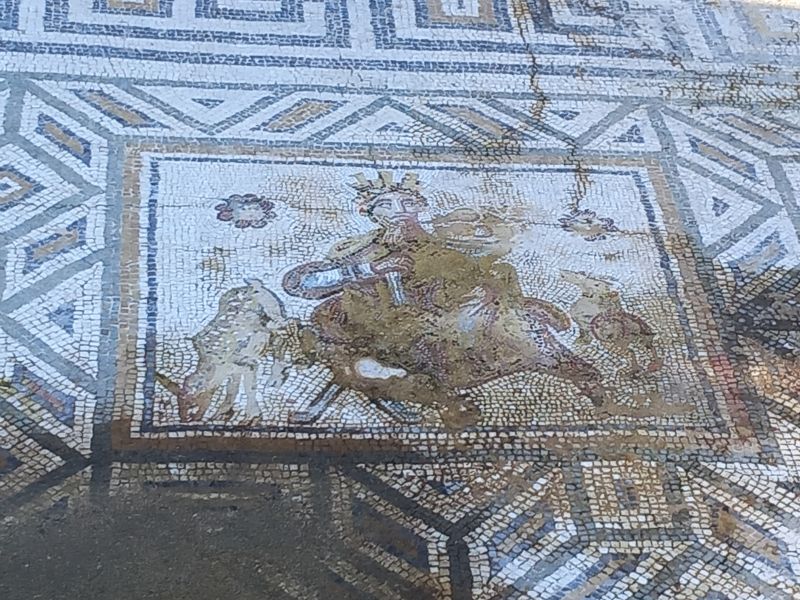- The Byzantine Episcopal Influence on the History of Side, Pamphylia
- Exploring Side, Pamphylia Hidden Byzantine Monuments
- The Lost Metropolis Episcopal Palace in Side, Pamphylia
- Discovering the Repurposed Chapel in Side Open Air Museum
- The Hidden Mosaics among the Side Market Shops – Part one
- The Hidden Mosaics among the Side Market Shops – Part Two
- The Hidden Mosaics among the Side Manavgat Shops – Part 3
- Hidden Things From Side’s Fountain to Grand Theater
- Hidden Crosses in the Side Archeology Museum
- Side’s Fascinating Basilica near Apollo Temple
- Analyzing the 12 churches and chapels of Side, Pamphylia
- Analyzing the Synagogue in Side, Pamphylia
As I delved into the Byzantine history of Side, I discovered that a recent archaeological dig found a synagogue. While navigating the streets of Side searching for this significant site, I received invaluable help from a Turkish man who guided me to its location. It’s important to note that the site is not well-marked, which adds to the challenge of finding it.
Jewish History in Side
The Jewish people settled in the city at least from the time of the Hasmoneans of Judea (from 140 BC). When the Roman Senate declared Asia a province in 129 BC, most likely renewed business developed in the city. Mark Wilson said, “Because of the large Jewish population in Pamphylia, Side was one of the cities notified by the Roman consul Lucius in 139 BC of a renewed alliance with the Hasmoneans of Judea. Side ‘should not seek their harm or make war against them and their cities and their country, or make alliance with those who war against them’ (1 Maccabee 15:19 NRSV).”[1] The synagogue discovered in 2021 dates back to the 7th century. Its size indicates a smaller community, but the residential area suggests a larger population.
According to Acts 2, on Pentecost, a group of Jews from Pamphylia heard the gospel of the resurrected Christ from the Apostle Peter. These Jews had come to Jerusalem for one of the three sacred pilgrimages: Passover, Pentecost, and the Feast of Booths. The regions mentioned all had extensive Jewish communities, and this passage shows their interest in the gospel. After hearing Peter’s message, many returned home and became some of the first Christians in Pamphylia. Furthermore, this shows a strong connection between Pamphylia and Jerusalem.
The Jewish Synagogue in Side
In 2021, the town’s renovation project uncovered a synagogue by removing most 20th-century buildings and revealing the remaining substructure below. This 7th-century mosaic flooring with a central marble tablet gives insight into Jewish history, “Among the remains was a plaque with a menorah motif and an inscription in Hebrew and Greek stating that it was donated by a father in honor of a son who passed away at 2.5 years old son. The plaque ends with the Hebrew word Shalom.”[1]https://arkeonews.net/ancient-synagogue-found-in-turkeys-popular-tourist-center-side/ The current exposed plague replicates the original, which archeology authorities moved to a local museum for a future exhibition.
On the circle tile is a seven-branch menorah with the inscription of which Professor Feriştah Alanyalı said, “Joseph from Korekesion (from Alanya) dedicated it to his son Daniel”.[2]https://arkeonews.net/ancient-synagogue-found-in-turkeys-popular-tourist-center-side/ In this case, Alanya is over 40 kilometers away, and the inscription shows the interactions of different Jewish communities in the region. Also, the original online and the replica on the ground differ. The original shows two birds feasting on the branches, like the Byzantine marble panels’ image of birds feasting on grapes or victory wreaths.[3]if I am not mistaken, since the image online is limited in quality These images carved on grave panels reflected their hope for eternal life. In this memorial, the father’s intent for his son runs deep in his dedicated inscription.
In the 7th century, the Jews constructed a synagogue despite being surrounded by dilapidated temples and a city heavily influenced by Christianity. Nevertheless, they maintained their faith and established a center for their Sabbath gatherings.

Central Boulevard
The synagogue rests East of the ancient Central Boulevard, the main route from the Theater to the South Basilica and Temple area. This boulevard is the heart of the city, prominently reflecting its political and religious values. The synagogue’s location along this main thoroughfare highlights the vital and respected role of the Jewish community in the city’s identity.

During my visit, the location was a challenge. My Google map gives the location, and my video below also provides it.
Jewish Neighborhood
Within the modern city block, the area just east of the synagogue shows a king-like image with many mosaic tiles. The image of the crowned man seems to have a deer on one side and a dog on the other. These mosaic stones appear to be Byzantine, while the area just to the right is more Jewish, with marble squares and cube-like stone designs.
Also, like the synagogue, the tiles are square and cubed like diamond-shaped tiles. The marble tiles form larger stones rather than the Byzantine mosaics in the city with small stones. In the Jewish temple, the holy of holes is a cubed-shaped space. 1 Kings 6:2 says the temple was shaped like a rectangle (60 by 20 cubits). Jewish floors used square patterns often. The mosaics found in Jerusalem from the second temple were square and triangle shaped.[4]https://www.scientificamerican.com/article/archeologists-restore-flooring-that-adorned-the-second-temple-of-jerusalem/
Gabriel Barkay, co-founder and director of the Temple Mount Sifting Project, described the second temple’s flooring, “First of all, all the measurements of the flooring tiles are…. colorful marbles with colored veins and patches,…In written sources, Flavius Josephus described the surroundings of the Temple as being paved with all kinds of colored stones, making reference to this type of flooring. Also, in the Talmudic literature, the sages described the site and spoke of the use of blue, red and white marble in the Temple.”[5]https://www.scientificamerican.com/article/archeologists-restore-flooring-that-adorned-the-second-temple-of-jerusalem/ So it appears when Jews designed synagogues in distant cities, these marble patterns reminded them of the Jewish temple. Even in the synagogue, the surrounding stones frame the marble squares.
These remains suggest the possibility of other synagogues in the region. While most archaeologists typically look for a Menorah to indicate a Jewish site, could the size of the location, along with the marble squares and cubes, also provide clues about other ruins in Asia Minor that may be of Jewish origin?

Mosaic of King David?
In the residency area near the synagogue, a mosaic of a crowned individual with what looks like a deer on one side and a dog on the other rests. The crowned bearded king sits with a scepter in his right hand and possibly on a throne. The Byzantines used the image of dogs for hunting, possibly here to a shepherd king. Does the mosaic show a harnessed dog? Many dogs in Byzantine mosaics showed that their owners trained for hunting.[6]See Amir Gorzalczany and Aiema Turkey, Tethering of tamed and domesticated carnivores in mosaics from the Roman and Byzantine periods in the southern Levant. Journal of Mosaic Research, 2018. For Jews living in a dominant Christian city in the 7th century, this depiction would grant favor from both sides.

Jewish Use of the Pomegranate
The name “Side” means Pomegranate in the old Sidean language. The Jewish High Priest adored their clothing with this fruit. Exodus 28:31 to 35 says,
31 “You shall make the robe of the ephod all of blue. 32 It shall have an opening for the head in the middle of it, with a woven binding around the opening, like the opening in a garment, so that it may not tear. 33 On its hem you shall make pomegranates of blue and purple and scarlet yarns, around its hem, with bells of gold between them, 34 a golden bell and a pomegranate, a golden bell and a pomegranate, around the hem of the robe. 35 And it shall be on Aaron when he ministers, and its sound shall be heard when he goes into the Holy Place before the Lord, and when he comes out, so that he does not die. (ESV)
The pomegranates hemmed with the bells represented beauty and abundance when the priest served in the presence of God. In the Old Testament, the pomegranate embodies prosperity and abundance, as highlighted in Numbers 13:23, Deuteronomy 8:8, and Haggai 2:19, standing as a powerful symbol of their aspirations, representing blessings and financial stability.
The Jewish settlers of Side would favor the name for these possible reasons, determined to create a vibrant community that would thrive for generations. Their commitment to building a synagogue was the cornerstone of their spiritual and social lives, alongside mosaic-tiled dwellings that would showcase their rich cultural heritage and artistry. This synagogue likely represented the culmination of a long-standing community presence in the city.
Other Synagogues in Pamphylia
Other remains of Jewish ruins have been found in Andriake (Synagogue in the town of Demre), Kaleiçi (Menorah), and Limyra (Greek inscription)—all in the Antalya region. Also, Jewish documents have been found in Phaselis, Antalya.[7]https://www.aa.com.tr/en/culture/new-istanbul-exhibit-sheds-light-on-jewish-history-on-turkish-soil/2411664 All these locations are in or West of Antalya. This synagogue and mosaics are the first in the Eastern Pamphylia region.
Given the region’s limited Jewish remains, this site gives tourists and historians a small glimpse into the 7th-century Jewish community.
See my Exploration of Side.
References
| ↑1, ↑2 | https://arkeonews.net/ancient-synagogue-found-in-turkeys-popular-tourist-center-side/ |
|---|---|
| ↑3 | if I am not mistaken, since the image online is limited in quality |
| ↑4, ↑5 | https://www.scientificamerican.com/article/archeologists-restore-flooring-that-adorned-the-second-temple-of-jerusalem/ |
| ↑6 | See Amir Gorzalczany and Aiema Turkey, Tethering of tamed and domesticated carnivores in mosaics from the Roman and Byzantine periods in the southern Levant. Journal of Mosaic Research, 2018. |
| ↑7 | https://www.aa.com.tr/en/culture/new-istanbul-exhibit-sheds-light-on-jewish-history-on-turkish-soil/2411664 |
Leave a Reply